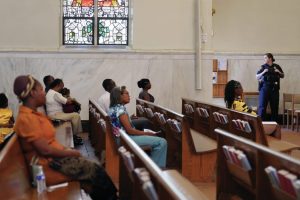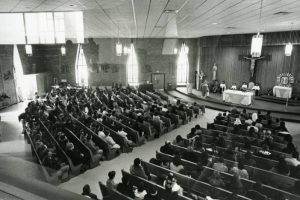“Ballet is a woman,” famously declared George Balanchine, the legendary choreographer who helped make The Nutcracker a holiday staple. At first glance, ballet appears to center women: Most dancers are female, most children in ballet classes are girls, and the audience is largely made up of women.
Yet behind the curtain, power still skews male. Despite women holding almost 61 percent of head-of-school positions in 2025, the Data Dance Project reports that 70 percent of artistic directors at major ballet companies are men. Gender stereotypes and inequities remain deeply entrenched in the realm of ballet. As a theologian who spent much of my childhood at the barre, I can’t help but see striking parallels between the world of ballet and the Catholic Church.
When church leaders say “the church is a woman,” I hear echoes of Balanchine. In both cases, the metaphor flatters, but it also obscures. It evokes beauty, devotion, and sacrifice while deflecting attention from the deeper issues of gender equity and inclusion. Just as women dominate the visible world of ballet but remain largely absent from positions of power, so too do they in the church: Catholic laywomen make up the majority of active parishioners, and the contributions of women religious remain vital. Yet women are still routinely excluded from leadership and decision-making, even consultative, roles.
Throughout the synod process, the exclusion and marginalization of women in the church emerged as a persistent, global concern. The North American synthesis document cited a “frequently heard call” to create more space for women in the church’s life and leadership. The basic diagnosis received unanimous consent: It is lamentable that women experience marginalization within the Catholic Church, and this must be addressed. And yet, in a striking contradiction, paragraph 60 of the synod’s final document—the one addressing the role and status of women—received the highest number of dissenting votes.
We agree that women belong, but we’re not always sure where they fit. This conversation goes beyond the question of the diaconate or ordination. It touches on something deeper: the meaning of vocation, belonging, and participation in the church. As we enter the implementation phase of the Synod on Synodality, it’s clear the church recognizes the need to make more space for laywomen. But what that means in practice remains unsettled. Without a shared vision or concrete action, efforts have largely stalled, and long-standing stereotypes about women’s roles continue to go unchallenged.
Where do women fit? And what would it truly take to make space for their full participation? The answers are complex. Both Pope Francis and the synod’s foundational document, “For a Synodal Church: Communion, Participation, Mission,” have called for the removal of barriers to women’s leadership—especially in roles already permitted by canon law. In 2021, Pope Francis changed canon law to formally allow women to be instituted as lectors and acolytes and established catechists as a new lay ministry. He also appointed more women to leadership roles within the Vatican curia.
In 2023, Pope Francis appointed three women—including a laywoman—to serve on the Dicastery for Bishops, the office responsible for identifying and recommending new bishops to the pope. Then-Cardinal Robert Prevost, who led the dicastery at the time, acknowledged the value of their contributions. In 2024, he told Catholic News Service that women often offered distinct perspectives and contributed “significantly to the process of discernment” in identifying the best candidates for episcopal ministry.
As Pope Leo XIV, one of his earliest appointments was to name Sister Tiziana Merletti as secretary of the Dicastery for Institutes of Consecrated Life and Societies of Apostolic Life. That office, which oversees men’s and women’s religious communities, now has a female prefect, a female secretary, and a woman serving as one of the two undersecretaries. It is fitting that the dicastery responsible for Catholic sisters has strong female leadership. But while these are meaningful developments, inclusion for laywomen in positions of ecclesial leadership still lags.
Over the past decade, many of us have not seen our own dioceses and parishes follow Pope Francis’ lead in expanding women’s leadership. Whose perspectives and voices, we might ask, are truly included in the discernment about the life of the community? The U.S. Conference of Catholic Bishops has yet to issue any national guidance or encouragement for dioceses to install laypeople into the ministries now formally open to them.
The leadership roles of lector, acolyte, and catechist are not merely administrative; they represent meaningful spaces for women’s participation in ministerial and liturgical life. In December 2024, Bishop John Stowe of Lexington, Kentucky, became the first U.S. bishop to formally act on this opportunity by installing three laywomen as acolytes. His action marked a concrete and public step toward opening new avenues for women’s leadership within his diocese and is a model for what implementation of synodal priorities looks like at the local level.
Catholic theology has long affirmed the equal dignity of women. Yet in practice, theological reflection has largely centered male experience as the norm for humanity. Much like in ballet, where women are idealized through the male gaze, female particularity is frequently reduced to the functions of childbirth and motherhood while male embodiment is treated as universal. As theologian Julie Rubio observes in her critique of Fratelli Tutti (On Fraternity and Social Friendship), “women, not men, are asked to read themselves into the document. . . . Brotherhood is universal, but sisterhood is not.”
In contrast, the Synod draws us back to a foundational truth: Baptism is the shared identity of all the faithful, women and men alike. To fully live out this baptismal identity, the church at every level must center the insights, experiences, and images of women as fully embodied human beings who equally reflect the image of God. Paragraph 60 of the Synod document calls for precisely this shift, urging “more attention be given to the language and images used in preaching, teaching, catechesis, and the drafting of official Church documents” and advocating greater inclusion of “the contributions of female saints, theologians, and mystics.”
The Synod reminds us that “by virtue of Baptism, women and men have equal dignity,” yet women still face obstacles to full recognition of their charisms and roles. A major challenge lies in how vocation is commonly understood—it is often narrowly equated with priesthood or religious life—making it a gendered concept that excludes many Catholics, especially laypeople. This framework also complicates inclusion of single people, who may not see their state of life as a vocation but rather as circumstance. On the other hand, colloquial discussions of discipleship emphasize a broader journey or path and offer a more inclusive lens. When vocation is reduced to a state of life, it risks marginalizing those who don’t fit traditional roles and anyone who doesn’t fit into that vision is suspect (like childless cat ladies).
In his homily at the Tomb of St. Paul, Pope Leo XIV offered precisely this kind of inclusive theology of vocation. “At the root of every vocation,” he preached, drawing on St. Augustine, “God is present in his mercy and goodness, as generous as that of a mother who nourishes her child.” He then cited Pope Benedict XVI’s message to young people, reminding them that at the heart of every vocation is the simple truth that “God loves us” and calling on them to “open our hearts to this mystery of love and to live as men and women conscious of being loved by God.”
Focusing on the broader vocation of discipleship, the Synod reminds us that “Baptism is the foundation of Christian life.” This vocation does not begin with gender or roles but with our shared baptismal identity. As we prayerfully reflect on living out discipleship, perhaps laywomen will no longer be treated as objects of ecclesial discourse but welcomed as full participants in the conversation.
United in baptism and called to be disciples, laywomen’s voices can—and should—be part of the church’s discernment on its synodal journey. Then, maybe, we can finally stop idealizing women while limiting their role—and instead remember that, like a well-choreographed ballet, the church comes alive when all of us move together.
Image: Unsplash/Colin Walsh

















Add comment